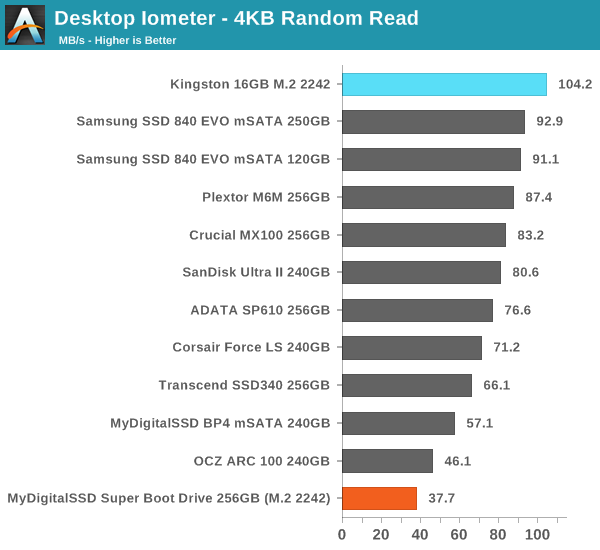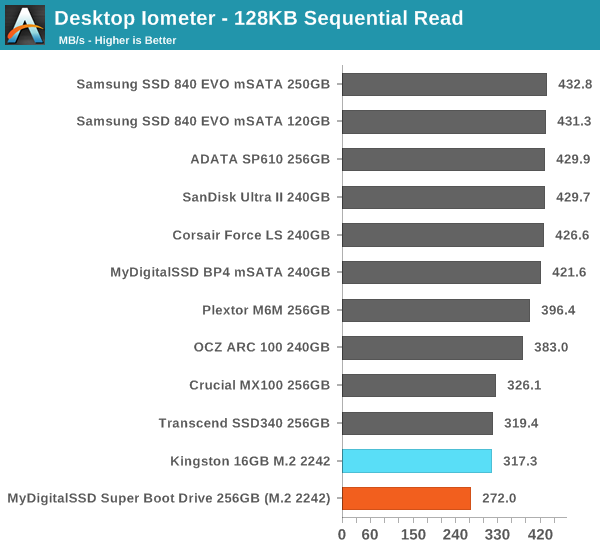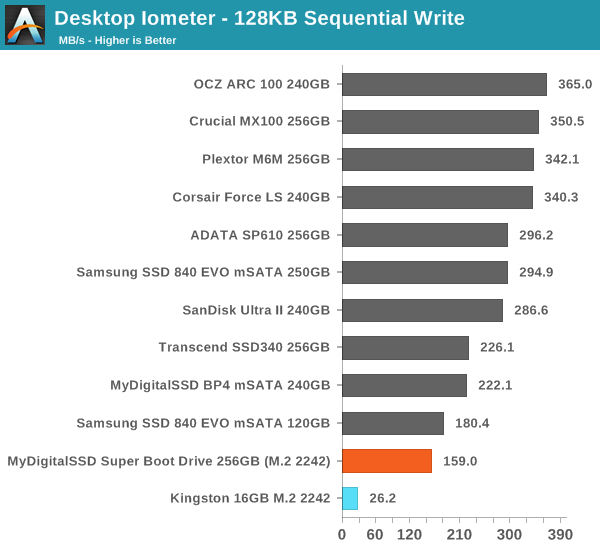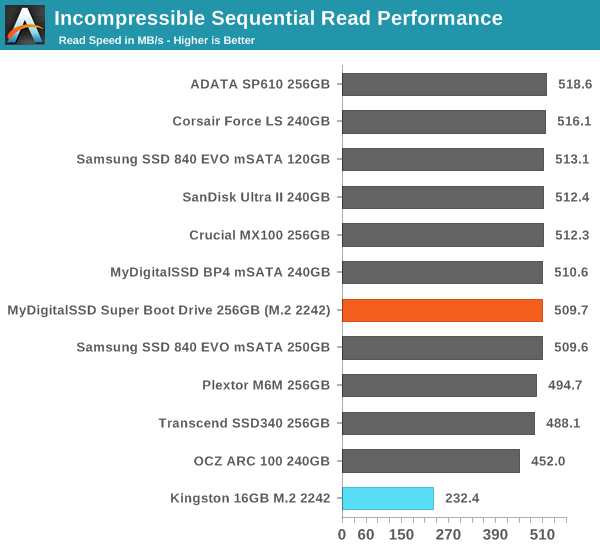Upgrading the SSD in Chromebook & MyDigitalSSD Super Boot Drive M.2 2242 SSD Review
by Kristian Vättö on October 21, 2014 8:00 AM ESTRandom Read/Write Speed
The four corners of SSD performance are as follows: random read, random write, sequential read and sequential write speed. Random accesses are generally small in size, while sequential accesses tend to be larger and thus we have the four Iometer tests we use in all of our reviews.
Our first test writes 4KB in a completely random pattern over an 8GB space of the drive to simulate the sort of random access that you'd see on an OS drive (even this is more stressful than a normal desktop user would see). We perform three concurrent IOs and run the test for 3 minutes. The results reported are in average MB/s over the entire time.

Surprisingly the 16GB Kingston M.2 drive has excellent random read performance. I suspect that having such little NAND helps with random read performance because you are practically hitting the same LBAs, so some IOs may be cached and there is less tracking overhead as well. The MyDigitalSSD drive, on the other hand, does not fare that well, although random read performance has never been the biggest strength of Phison controllers in my experience.


Both the MyDigitalSSD and Kingston drives have rather poor random write performance. Since neither of the drives have a DRAM cache, the host IOs along with the NAND mapping table need to be cached in the internal cache of the controller (or alternatively in NAND), which adds limitations since the internal SRAM caches are typically only a few megabytes in size and NAND is much slower than DRAM.
Sequential Read/Write Speed
To measure sequential performance we run a 1 minute long 128KB sequential test over the entire span of the drive at a queue depth of 1. The results reported are in average MB/s over the entire test length.

Sequential read is also better on the 16GB Kingston drive, so it seems that the additional NAND adds quite a lot of overhead when there is no DRAM for caching purposes. In write speed the MyDigitalSSD drive is considerably faster, although 2.5" 256GB drives are also substantially faster still.

AS-SSD Incompressible Sequential Read/Write Performance
The AS-SSD sequential benchmark uses incompressible data for all of its transfers. The result is a pretty big reduction in sequential write speed on SandForce based controllers, but most other controllers are unaffected.












67 Comments
View All Comments
hojnikb - Tuesday, October 21, 2014 - link
Given the space constraints of the 2242, wouldn't make more sense to go with something like sandforce ?This is already designed with dramless in mind, so it would perform better. And at this point, these old controllers must be dirt cheap.
Also one more thing. Given how many cheap laptops use eMMC instead of real ssds, would it be possible to test that aswell ? As i'm aware, eMMC solutions are usually not that fast, but i do wonder how slow they really are.
III-V - Thursday, October 23, 2014 - link
eMMC 5.0 should be very fast, and should be surfacing in devices this year.noelbonner - Tuesday, November 11, 2014 - link
I'd go for one of the top laptops on the market instead (like the rankings at http://tinyurl.com/msegfz9 for example).duploxxx - Tuesday, October 21, 2014 - link
Anandtech quote:While the whole netbook boom kind of died with the introduction of tablets, Chromebooks have been gaining more and more traction recently. The original Windows netbooks failed to provide a smooth user experience due to the lack of operating system optimization, and Windows was simply way too heavy to be run with such limited resources
requires a BIG correction, AMD Brazos was and still is more then fine to run these netbook designs, a 7.2k or better SSD HD gives a very good daily usage of that device. It are the horrible ATOM all over the world thx to Intel and OEM designs that screwed the netbook usecases......
just like first generation ATOM for tablet is useless and made th windows tablet flop.
lilmoe - Tuesday, October 21, 2014 - link
Exactly. Hardware played a larger role in the failure of netbooks. It was simply too slow, and low power processors weren't "there" yet.Microsoft should make a huge comeback with Windows 10 in netbook form factor. Interesting will be the price and capabilities of these devices. Good performing $150-$250 Windows 10 netbooks will eat Chromebooks' lunch and make it seem they never really existed.
titaniumalloy - Tuesday, October 21, 2014 - link
I think the biggest problem is that they had stupid slow 320GB HDD. If they had used 16GB SSD, the machines would have been good. Of course, SSD were pricey 4 years ago. I believe if Microsoft come back into the netbook arena, they would perform well. Microsoft is usually way to ahead of its time or too far behind.hojnikb - Tuesday, October 21, 2014 - link
Dont forget. Very first netbooks were fitted with ssds (very small ones though).andrewaggb - Tuesday, October 21, 2014 - link
I owned 2 netbooks, one with an atom processor and a 1024x600 res screen, one with an amd c50 and 1280x720 screen.I hated them both. The keyboards were small and cramped, the screen resolution on both needed to be 768 minimum height. The hard disks were painfully slow, it took forever to get anything loaded. The amd c50 cpu was awful. It was cpu bound by all sorts of things and not nearly enough applications were gpu accelerated.
Personally, I think the 11-13" laptop range is a much better size, with at least a 1366x768 resolution and an ssd. We have those today, but not for $200.
I'd definitely rather have windows than a chromebook, but microsoft needs to get their windows updates streamlined and smaller...
jabber - Wednesday, October 22, 2014 - link
I've tried some of the new ultra cheap Windows 8.1 laptops with AMD E1 CPUs etc. and they are terrible. The CPU is so underpowered it runs at 100% the whole time. Poor HDD performance etc. Miserable experience. The problem is these are the new cheap laptops folks are buying. Makes you really appreciate a lowly Athlon or Celeron CPU, at least they worked. In comparison a Chromebook works far better for the average Joe.abianand - Thursday, October 23, 2014 - link
Let us hope the laptop manufacturers stop pairing Windows 8.1 only with slow CPUs.Richland and Kaveri have many design wins and have many (I say many, keeping in mind I'm talking about AMD CPUs here) laptops in the US market but not in many other countries.